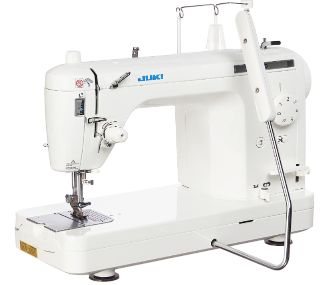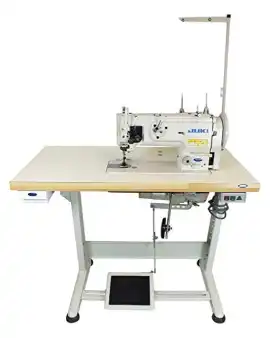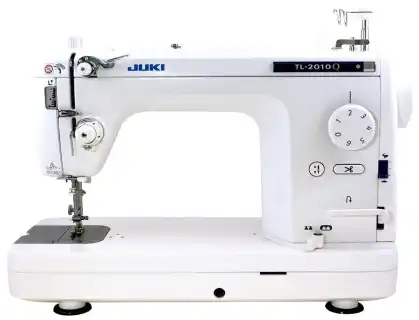Finding the best Juki sewing machines for leather projects requires understanding the unique demands of working with leather. Leather’s thickness and rigidity make it difficult to maneuver through regular sewing machines.
Juki has become a popular brand for heavy duty sewing machines for leather work due to the robustness and versatility of their models. This blog post provides an in-depth look at key Juki sewing machines for leather projects.
We will examine the features and capabilities of top Juki models like the TL-2000Qi, DNU-1541S, and TL-2010Q.
The goal is to help readers select the ideal Juki machine for their specific leather sewing needs after reviewing essential factors like power, stitch strength, adjustability and more.
Whether you are a leather crafting enthusiast, small business owner or a professional seeking industrial sewing machines for leather, this guide covers it all.
Understanding Leather Sewing Challenges
Sewing leather requires heavy duty sewing machines that can handle the unique properties and demands of this material.
Leather’s dense, rigid structure makes it difficult for regular sewing machines to stitch through. The material’s thickness swiftly causes strain on the motor, leading to sewing machine maintenance issues or breakdowns.
Leather’s texture also causes slippage and inaccurate stitch placement when using normal presser feet and feed mechanisms. These frustrations result in uneven stitches, needle jams, thread fraying, and material distortion.
Without the right leather sewing machine, projects take longer to complete and lack the quality finish that skilled crafters desire. Investing in an industrial-grade or specialized leather sewing machine saves time, reduces headaches, and elevates the final product’s appearance.
Juki understands the headaches of sewing machines for leather projects. That’s why their machines feature robust motors, customized feed systems, and adjustable components to conquer these difficulties.
When shopping for a Juki leather sewing machine, prioritize models that highlight presser foot adaptability, reliable needle penetration, high motor speed, consistent stitch formation and sturdy yet smooth material handling.
Paying attention to these performance metrics helps narrow the options to find your ideal Juki partner for leather sewing projects.
Benefits of Juki Sewing Machines for Leather
Juki sewing machines provide crafters, entrepreneurs, and industry workers with the ideal tools for taking on leather sewing projects. Juki’s decades of experience making industrial-level machines gives them an edge in the heavy duty sewing niche.
Their dedication to innovation empowers them to constantly improve upon and perfect the staples that leather sewing professionals need. When you choose Juki, you access this legacy of quality engineering combined with pioneering technology.
Juki’s line-up includes specialty leather sewing machines alongside their all-purpose models. For example, the Juki DNU-1541S showcases an industrial-style walking foot perfect for thick leathers.
The Juki TL-2000Qi provides home sewers a powerhouse for large-scale quilting or leatherwork using its swift needle speed and generous workspace. Those seeking a multi-purpose workhorse should look at the nimble and efficient Juki TL-2010Q.
Digging into sewing machine reviews and user experiences reveals telling insights about Juki’s edge in leathercraft capabilities:
- “This Juki sewing machine is a beast! I use it every day for my small leather goods business. It plows through multiple layers of thick leather without hesitation.”
- “I’ve tried cheaper machines in the past but they just can’t compare to the power and performance of my Juki for leather projects. Worth every penny!”
- “After struggling with my old sewing machine, I took the plunge and bought a Juki TL-2000Qi for my handbag and luggage prototyping business. My production time has been cut in half and the quality is superb.”
These perspectives reinforce that Juki equips crafters and professionals to complete leather sewing tasks with reduced effort and optimized results. Key advantages include:
- Powerful motors optimally designed for piercing leather’s rigid structure
- Specialized walking feet to grip and guide leather through stitching
- Industrial-level speed for efficiency in mass production or batches
- Smooth material handling even at high velocities
- Rugged metal chassis that withstands constant leatherwork use
- Precise stitch placement and strength using ideal needles & threads
- Sufficient adjustability to customize presser foot pressure as needed
By leveraging these assets, Juki builds versatile yet specialized machines for leather sewing suitable for everyone from Etsy sellers to enterprise-level manufacturers.
Top Juki Models for Leather Sewing
When researching the best Juki sewing machines for leather, three exceptional models rise to the top:
These industrial sewing machines for leather represent the cream of the crop in Juki’s catalog based on performance, features, and reputation.
The Juki TL-2000Qi dazzles as a quilting and leatherwork powerhouse. Capable of up to 1500 SPM with a piercing needle speed, this muscular machine zooms through substantial leather projects. Its industrial pedigree also provides perks like a lift lever for adjusting presser foot height.
Next up, the Juki DNU-1541S earns acclaim for its specialist walking foot built to feed leather smoothly and evenly. Backed by a sturdy metal interior, this model offers both reliability and specialist capability for leatherworkers.
Finally, the Juki TL-2010Q warrants mention as a multi-purpose workhorse ready to switch from garment construction to leather crafts. Its automatic thread trimmer and swift needle speed notably increase efficiency for volume work.
| Machine Model | Key Benefits | Max Speed | Key Feature |
|---|---|---|---|
| Juki TL-2000Qi | Heavy duty, long stitch ability | 1500 SPM | Adjustable presser foot |
| Juki DNU-1541S | Specialized walking foot | 1500 SPM | Box feed mechanism |
| Juki TL-2010Q | High speed, automatic thread trimmer | 1500 SPM | Wide workspace |
This overview of premier options kickstarts the research process so crafters can select their ideal Juki leather sewing machine.
Juki TL-2000Qi
The Juki TL-2000Qi stands out as a heavyweight contender for serious leatherwork and quilting. This brute combines industrial-level power with accessible operation for home sewers.
Overview
As Juki’s top-tier home machine, the TL-2000Qi packs a punch yet won’t overwhelm novice users. A powerful direct drive motor allows continuous high-speed sewing up to 1500 SPM on all fabric types. Juki’s excellent engineering offers precise stitch placement even at max velocity.
The TL-2000Qi zips through thick material like leather without distortion or slipped stitches.
Key Features
- Powerful 1500 SPM direct drive motor
- Automatic thread cutter for efficiency
- Knee lift lever for hands-free operation
- Large extension table and wide flat bed
- Needle plate with scale for seam spacing
- Adjustable stitch length up to 6mm
Performance
This heavy duty sewing machine for leather astounds with its effortless piercing through dense, rigid leather. The motor never bogs down even when stitching multiple layers of heavyweight leather. A flick of the knee lever allows pivoting large pieces.
Generous clearance slide-on extension table provides ample support for bags and clothing. The TL-2000Qi makes light work of long seams in leather garments, straps, holsters, luggage and more. Quilters will also delight in swiftly finishing big, quilted pieces without fatigue.
Ease of Use
Despite its professional caliber performance, the TL-2000Qi offers intuitive operation. Convenient one-touch buttons make selections like stitch length and type a breeze. The knee level allows moving projects hands-free. Cuts down on neck and shoulder strain. A large LCD screen displays selected options clearly.
For home sewers seeking the versatility to switch between quilting and leatherwork, the Juki TL-2000Qi is a star player. This mighty machine will continue churning out quality results on heavy fabrics as your skills progress.
Here is an in-depth review of the Juki TL-2000Qi leather sewing machine:
Juki DNU-1541S
The Juki DNU-1541S provides a purpose-built leather sewing beast thanks to its walking foot feed system. This specialty feature makes it a top pick for leatherworkers.
Overview
As an industrial grade machine, the Juki DNU-1541S offers power and reliability for heavy use. The integrated unison feed walking foot gives expert feeding and handling of leather pieces. No need to attach a separate foot. Operators can dive right into sewing sturdy materials thanks to specialized engineering.
Key Features
- Integrated walking foot feed system
- Box feed mechanism for precise stitching
- 1500 SPM maximum sewing speed
- Automatic needle threading
- Knee lifter and extra high presser foot lift
- Needle plate with measurement markings
Performance
The unison walking foot on the DNU-1541S vastly improves stitch quality in leather pieces. It feeds material evenly and prevents layers from slipping out of alignment. The box feed mechanism delivers exact stitch placement even at high velocity.
Switching roller feet to handle slick leather takes seconds thanks to the quick change system. This machine sews straight as an arrow through leather up to 9mm thick thanks to the powerhouse motor.
Ease of Use
This is an industrial Juki model, but it provides helpful functions for the operator. Knee lifter and generous presser foot lift simplify sliding thick material under the foot. One-touch buttons make selections straightforward.
The wide flat bed offers ample work surface for large projects. Quick-set bobbin and automatic needle threader also minimize set-up time.
For leatherworkers seeking the perfect walking foot sewing machine, the specialized Juki DNU-1541S represents the ideal blend of ease-of-use and hardworking performance. Crafters who frequently work with heavyweight leather will benefit the most from its engineering.
Here is an in-depth review of the Juki DNU-1541S leather sewing machine
Juki TL-2010Q
The Juki TL-2010Q is a versatile powerhouse ready to sew leather alongside delicate fabrics thanks to convenient features and swift speed.
Overview
This Mechanical Sewing Machine packs performance for tackling everything from silk to leather. The TL-2010Q’s range impresses hobbyists and small business owners alike. Expect reliability from its clutch motor and rugged engineering.
Key Features:
- Speeds up to 1500 SPM for efficiency
- 87 square inches of workspace
- Automatic thread trimmer
- Industrial style lift lever
- Drop feed for free motion work
- Free motion foot included
Performance on Leather
With a piercing needle speed, leather projects make easy work for the TL-2010Q. The powerful motor chugs through thick seams without hesitation. Long jackets, sturdy bags, and yards of straps get finished swiftly.
Moving the motor frees up ample space for guiding leather pieces through the needle area. The machine’s industrial pedigree means it will continue churning out consistent stitches on leather for years.
Ease of Use
Despite swift speeds, this Juki model welcomes beginners with its dial adjustments and button controls. Little time needed to set stitch length, width, or swap presser feet. The free motion foot prevents drag when hand-guiding leather.
Easy bobbin access and automatic threading increase convenience.
For leather crafting or production on a range of fabrics, the Juki TL-2010Q promises years of reliable service. Home sewers and small manufacturers will benefit from its well-rounded performance and ease of operation.
Here is an in-depth review of the Juki TL-2010Q leather sewing machine
Factors To Consider When Selecting a Juki Leather Sewing Machine
Investing in a Juki leather sewing machine involves evaluating your needs and project plans. Important factors to weigh include:
- Motor power and maximum speed – More power and higher speed allow efficiently punching through thick leather.
- Specialized presser feet – Adjustable, heavy duty, or walking feet provide ideal leather handling.
- Feed mechanism – Robust feed systems improve stitch precision on leather.
- Stitch strength and options – Reliable stitches and options like extra long stitches accommodate leatherwork.
- Needle system – Industrial needles and easy threading prevent snapping or jams.
- Thread compatibility – Using thicker threads suited for leather materials.
- Workspace size – Ample room for handling large leather pieces.
- Noise level – Quieter motors reduce fatigue from long sewing sessions.
- Cost – Budget will determine which models are affordable.
Carefully evaluating choices using this criterion ensures your Juki sewing machine for leather aligns with your:
- Project types – Apparel, gear, accessories, furnishings etc.
- Leather thickness – Thin garment types up to heavy duty tooling leather.
- Skill level – Beginner, intermediate, expert, or industrial.
- Frequency of use – Occasional or daily high-volume.
- Workspace available – Home studio or commercial facility.
Taking stock of your current and future needs will guide you toward the ideal Juki model to fulfill your leather sewing machine aspirations. Test driving display models also provides invaluable hands-on insight.
Tips for Leather Sewing with Juki Machines
Once you’ve selected the perfect Juki leather sewing machine for your work, it’s time to delve into best practices for using your new investment effectively. Follow these pro tips and techniques for leatherwork success:
- Choose needles wisely – Use the proper size and point style needle. Consider a leather needle with a wedge point and non-stick coating.
- Optimize thread selection – Heavier threads like bonded nylon are ideal for leather’s density. Match thread weight to needles.
- Get the presser foot pressure right – Start on the high end then dial back until stitch formation is optimal.
- Mind the stitch length – Longer stitches (4mm+) allow leather layers to pass smoothly.
- Employ a roller or Teflon foot – Reduces friction and sticking for slick leathers.
- Use an appropriate thread tension – Keep tension moderately tight so stitches securely anchor into the leather.
- Go slow initially – Let the machine work through heavy or stuck areas then increase speed.
- Use fresh blades and oil – Replace dull rotary cutter blades. Keep machine oiled for smooth operation.
- Let leather acclimate first – Allow leather to normalize to workspace temperature and moisture levels before cutting and stitching.
- Do test samples – Experiment with scrap leather using adjusted settings to find the sweet spot.
Patience and practice will pay off when mastering your Juki sewing machine for leather. Refer to your device’s manual for model-specific guidance as well.
Conclusion
Juki sewing machines earn their sterling reputation by empowering crafters to bring their leather visions to life. Their specialized engineering and user-friendly designs make Juki models ideal for both novice and experienced leatherworkers.
This guide provides the essential background for selecting the best Juki machine for your projects and skill level. While options like the TL-2000Qi, DNU-1541S and TL-2010Q rise to the top, evaluating your own needs is key. Seek out a Juki device with the right blend of power, durability, and features to match your workspace and sewing style.
Owning a quality Juki machine also unlocks new creative opportunities with leather. Their efficiency and smooth handling open doors for starting a leather goods business, expanding your skills, or simply enjoying your craft more. We hope this exploration of Juki’s leather sewing prowess informs your purchasing decisions and future projects.
Please share your experiences and insights about Juki sewing machines in the comments below!



